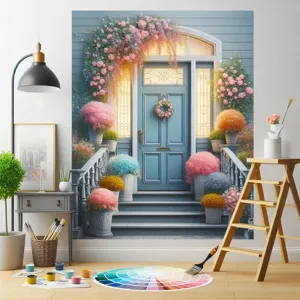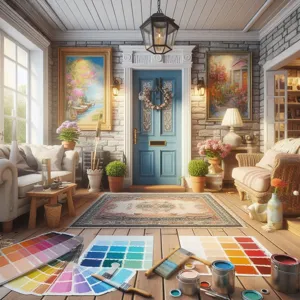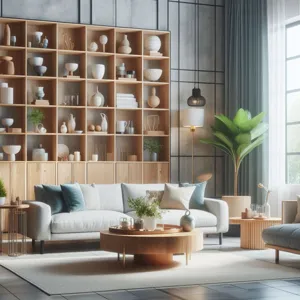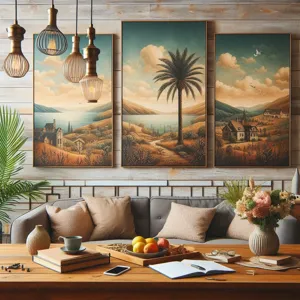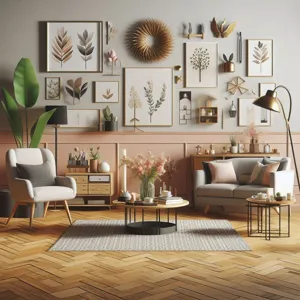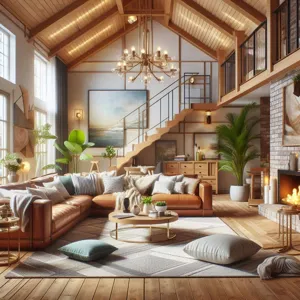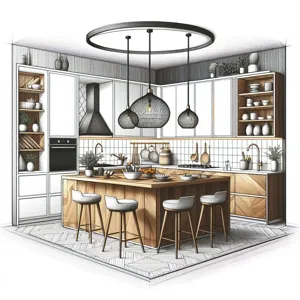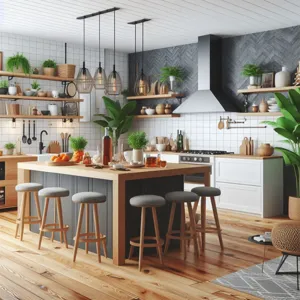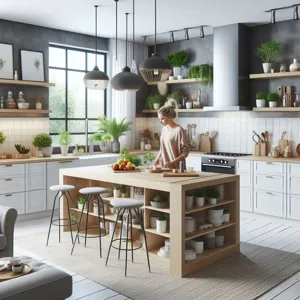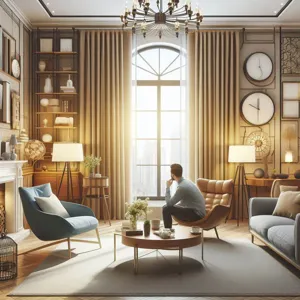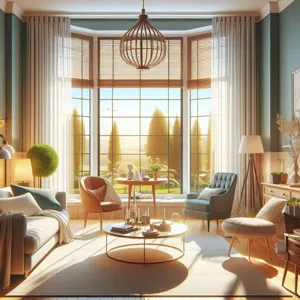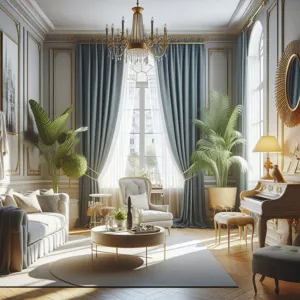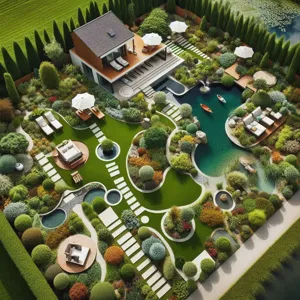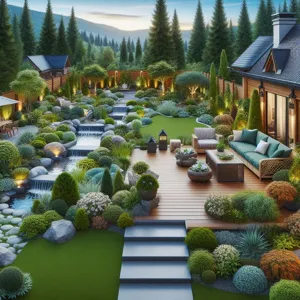In an era where remote work is becoming the new norm, creating a home office that balances functionality and style is more important than ever.
Your workspace should not only inspire productivity but also reflect your personal aesthetic, making it a comfortable sanctuary where creativity can flourish. Whether you’re a seasoned professional or a budding entrepreneur, the right environment can significantly enhance your focus and efficiency. From choosing the perfect desk and ergonomic chair to incorporating smart storage solutions and inviting decor, the design elements of your home office can make all the difference. In this blog post, we’ll explore ten essential tips to help you craft a workspace that is both practical and visually appealing, ensuring that you can tackle your to-do list in style while enjoying the comforts of home. Get ready to transform your workspace into a haven of productivity and inspiration!
1. Assessing Your Needs: Understanding Your Work Style
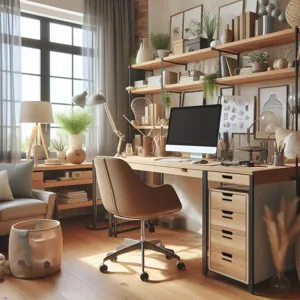
Designing a home office that strikes the perfect balance between functionality and style begins with a thorough assessment of your unique needs. Understanding your work style is crucial; it sets the foundation for every decision you’ll make in the design process. Are you a creative who thrives in a vibrant, inspiring environment, or do you prefer a minimalist setup that allows for focused productivity? Reflecting on how you work can guide you in selecting the right furniture, layout, and decor.
Start by examining your daily tasks. Do you spend hours on video calls, requiring a well-placed backdrop and great lighting? Or perhaps you need a large desk space for spreading out documents and brainstorming ideas? Take stock of the equipment you rely on—computers, printers, and other tools—and consider how much space they require.
Next, think about your workflow. Do you favor an open, airy layout that encourages movement and collaboration, or do you need a more enclosed space for privacy and concentration? Creating zones within your office can cater to different aspects of your work; for instance, a comfortable reading nook for research or a designated area for meetings.
Don’t forget to factor in your personal style. Your home office should reflect who you are, making it a place you enjoy spending time in. Whether you prefer bold colors or a neutral palette, incorporating elements that inspire you—such as artwork, plants, or personal mementos—can transform a functional workspace into a stylish retreat.
Ultimately, assessing your needs means taking the time to understand how you work best and what elements will enhance your productivity. By aligning your design choices with your work style, you’ll create a home office that not only serves its practical purpose but also fosters creativity and motivation, making it a true sanctuary for your professional endeavors.
2. Choosing the Right Location: Maximizing Space and Natural Light
Choosing the right location for your home office is pivotal in creating a space that is not only functional but also inspires creativity and productivity. Start by assessing your home layout and identifying areas that can accommodate your office setup without disrupting the flow of your daily life. Ideally, you want a space that is quiet and separate from high-traffic areas, allowing you to focus on your tasks without constant distractions.
Maximizing natural light is another crucial factor in designing your home office. A well-lit space can significantly enhance your mood and energy levels, making you feel more engaged and less fatigued throughout the day. Position your desk near windows to take advantage of sunlight, but also consider how the angle of the light changes throughout the day. If your workspace lacks sufficient natural light, incorporate bright, warm artificial lighting to create an inviting atmosphere.
Additionally, think about the layout of your chosen space. Open spaces can feel airy and less confined, while a cozy nook can provide a sense of comfort. Whatever your preference, ensure you have enough room to move around freely and that the setup allows for easy access to your tools, whether it’s your computer, notebooks, or creative supplies. Adding plants or greenery can also enhance the ambiance and improve air quality, making your office a refreshing retreat where you can thrive both functionally and stylistically.
By thoughtfully selecting your office’s location and maximizing natural light, you’ll cultivate a home office that not only looks great but also supports your productivity and well-being.
3. Selecting Functional Furniture: Ergonomics Meets Aesthetics
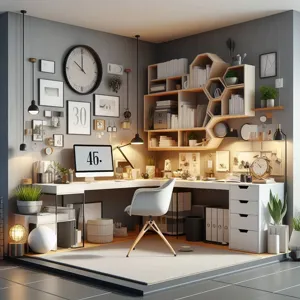
When it comes to designing a home office, the furniture you choose plays a pivotal role in both functionality and style. Selecting functional furniture means striking the perfect balance between ergonomics and aesthetics, ensuring that your workspace not only looks appealing but also supports your well-being and productivity throughout the day.
Start with the essential piece: your desk. Opt for a model that offers ample surface area for your computer, paperwork, and personal items while fitting seamlessly into your design scheme. A standing desk or an adjustable height option can provide versatility, allowing you to switch between sitting and standing, which can significantly enhance your comfort and focus. Pair it with an ergonomic chair that encourages good posture, featuring adjustable height, lumbar support, and breathable materials. This investment in your health pays off, as it helps prevent discomfort and fatigue during long work hours.
Next, consider storage solutions that blend seamlessly with your décor. Floating shelves, stylish filing cabinets, or multi-functional bookcases can keep your workspace organized while adding to the overall aesthetic. Choose furniture pieces that reflect your personal style—be it modern, rustic, or minimalist—to create a cohesive look that inspires creativity and motivation.
Don’t forget about the little touches that make a big impact. Incorporating decorative elements such as a chic desk lamp, vibrant wall art, or lush plants can brighten your space and enhance your mood. Select colors and textures that resonate with you, as they can influence your productivity and mindset.
In summary, when selecting functional furniture for your home office, prioritize ergonomics without sacrificing style. By creating a workspace that is both comfortable and visually pleasing, you’ll cultivate an environment that not only supports your work but also reflects your unique personality, making it a place where you can thrive.
4. Creating a Productive Layout: Zoning Your Space
When it comes to designing a home office that is both functional and stylish, creating a productive layout through effective zoning is key. Zoning refers to the practice of dividing your workspace into distinct areas that cater to different tasks, helping you to maintain focus and efficiency throughout your day.
Start by identifying the primary functions your home office will serve. Are you primarily working on a computer, holding video calls, or engaging in creative tasks like brainstorming or crafting? Once you have a clear understanding of your needs, you can designate specific zones. For instance, your main workstation should be positioned in a way that minimizes distractions while maximizing natural light. A dedicated area for meetings—whether virtual or in-person—should be equipped with comfortable seating and perhaps a visual backdrop that reflects your professionalism.
Consider adding a cozy reading nook or a brainstorming corner, complete with a comfortable chair and a small table for notes or sketches. This separate space can serve as a retreat when you need a break from screens, allowing your mind to wander and fostering creativity. Use rugs or furniture placement to visually differentiate these zones without creating physical barriers, maintaining an open and inviting atmosphere.
Don’t forget about the importance of organization within each area. Utilize shelves, storage bins, and desk organizers to keep clutter at bay. By creating a layout that clearly delineates work zones, you not only enhance your productivity but also create a visually appealing home office that reflects your personal style. With thoughtful zoning, your workspace can become a harmonious blend of functionality and aesthetic appeal, inspiring you to tackle each task with renewed energy and focus.
5. Color Psychology: Choosing the Right Palette for Focus and Inspiration

When it comes to designing a home office, the colors you choose can significantly impact your mood, productivity, and overall work experience. This is where the fascinating concept of color psychology comes into play. Different hues evoke various emotions and responses, making it crucial to select a palette that fosters focus and inspiration.
For a productive environment, consider opting for shades of blue. Known for its calming effects, blue can help reduce stress and enhance concentration, making it an ideal choice for tasks that require deep thinking and creativity. Pair it with crisp white accents to create a clean, fresh look that promotes clarity and organization.
If you’re looking to ignite creativity, consider incorporating pops of yellow. This cheerful color stimulates mental activity and encourages original thinking. A yellow accent wall or decorative elements—like a bright desk lamp or inspiring artwork—can add a burst of energy and creativity to your space without overwhelming it.
For those seeking a more grounded atmosphere, earthy tones like greens and browns can create a serene and balanced environment. Green, in particular, is associated with nature and can help reduce fatigue and improve overall well-being. A few potted plants can complement this palette beautifully, bringing a touch of nature indoors while enhancing air quality.
Lastly, don’t underestimate the power of neutrals. Grays and soft beiges provide a versatile backdrop that can be easily accented with colorful accessories and furniture. They create a sophisticated and timeless look while allowing you to switch up the decor as your style evolves.
Incorporating color psychology into your home office design not only enhances its aesthetic appeal but also plays a vital role in your productivity and creativity. So take the time to explore different color combinations and find the perfect palette that resonates with your personal style and work needs. Your ideal workspace is just a brushstroke away!
6. Incorporating Storage Solutions: Keeping Clutter at Bay
A well-organized home office is the backbone of productivity, allowing you to focus on your tasks without the distraction of clutter. Incorporating effective storage solutions is key to maintaining a clean and stylish workspace. Start by evaluating your specific storage needs—do you have a plethora of documents, supplies, or digital devices that require organization? Once you identify what you need to store, you can choose from a variety of stylish solutions that enhance both functionality and aesthetics.
Consider utilizing vertical space with wall-mounted shelves or cabinets, which not only save floor space but also provide a chic display for books and decorative items. Opt for modular shelving units that can be adjusted and reconfigured as your needs change. These can be a perfect canvas for personalizing your space while keeping essentials within easy reach.
In addition to shelves, think about multi-functional furniture. Desks with built-in drawers or side tables that double as storage can keep your workspace streamlined. Stylish storage boxes or baskets can help contain smaller items, while also adding a touch of decor. Choose colors and materials that complement your overall office theme—think wooden boxes for a rustic vibe or sleek metal containers for a modern touch.
Lastly, don’t forget about the power of hidden storage. Invest in furniture pieces that offer concealed compartments, like an ottoman or a coffee table with storage space, to keep less frequently used items out of sight. By thoughtfully incorporating these storage solutions, you’ll create a home office that is not only functional but also a reflection of your personal style, allowing you to work efficiently in an inviting environment.
7. Lighting Matters: Balancing Natural and Artificial Light

Lighting is one of the most crucial elements in creating a functional and stylish home office. It has the power to influence your mood, productivity, and overall well-being. Striking the right balance between natural and artificial light can transform your workspace from a dull corner to an inspiring hub of creativity.
Start by maximizing natural light. Position your desk near a window to take advantage of sunlight, which not only brightens your space but also boosts your energy levels. Natural light has been shown to enhance focus and reduce eye strain, making it an essential component of a productive work environment. Consider using sheer curtains or blinds that can filter harsh sunlight while still allowing ample light to flow in.
However, relying solely on natural light isn’t always practical, especially during the shorter days of winter or in rooms that don’t receive much sun. This is where artificial lighting comes into play. A combination of ambient, task, and accent lighting can create a well-rounded lighting scheme. Ambient lighting provides overall illumination, while task lighting—such as a desk lamp—focuses light on your work area, making it easier to read and write without straining your eyes.
When selecting light fixtures, opt for adjustable lamps that allow you to direct light where you need it most. Consider the color temperature of your bulbs, as warmer tones can create a cozy atmosphere, while cooler tones promote alertness. Aim for a mix of both to cater to different tasks and times of day.
Lastly, don’t forget about the aesthetic aspect of your lighting. Choose fixtures that complement your office décor and add a touch of style. Whether it’s a sleek modern lamp or a vintage-inspired pendant, the right lighting can enhance the overall design of your home office while providing the functionality you need to stay productive.
In summary, thoughtful consideration of your lighting choices can create a harmonious balance between style and practicality, ensuring your home office is a space where you can thrive.
8. Personalizing Your Workspace: Infusing Your Style and Personality
Creating a home office that reflects your unique style and personality is more than just an aesthetic choice; it’s a way to cultivate an environment that inspires productivity and creativity. Personalizing your workspace allows you to transform a standard office setup into a space that feels distinctly yours, making it a pleasure to spend hours working.
Start by incorporating colors that resonate with you. Whether it’s a bold accent wall, vibrant artwork, or a selection of colorful accessories, these elements can energize your space. For those who prefer a calming environment, consider softer hues or natural tones that promote focus and relaxation.
Next, think about the decor that speaks to your interests and passions. Displaying photographs of loved ones, artworks that inspire you, or items that represent your hobbies can create a more inviting atmosphere. Shelves filled with your favorite books or decorative items not only serve as a personal touch but can also spark conversations with visitors or clients.
Don’t forget about functional personalization. Invest in office supplies and furniture that not only look good but also fit your working style. Ergonomic chairs, stylish organizers, and sleek desk lamps can blend functionality with flair. Adding plants or succulents can also breathe life into your workspace, improving air quality and adding a touch of nature to your design.
Lastly, consider the little details—your choice of desk accessories, the type of lighting, and even the scent in the room can contribute to the overall feel of your office. Opt for candles or diffusers with scents that help you concentrate and feel energized. By thoughtfully infusing your personality into every aspect of your workspace, you’ll create a home office that motivates you to achieve your best work while feeling completely at ease.
9. Technology Integration: Ensuring Efficiency and Connectivity
In today’s fast-paced digital world, a home office that blends functionality with style must prioritize technology integration. Ensuring efficiency and connectivity is not just about having the latest gadgets; it’s about creating a cohesive environment that supports your workflow while reflecting your personal aesthetic.
Start by evaluating your core technological needs. Do you require multiple screens for multitasking? A high-quality webcam for virtual meetings? Or perhaps a robust printer to handle your printing needs? Once you’ve identified the essential tools, consider how they will fit into your design scheme. Choose sleek, modern devices that complement your decor, rather than clash with it. Wireless technology can be a game changer here, as it eliminates unsightly cords and creates a cleaner, more organized workspace.
Next, think about your internet connectivity. Reliable Wi-Fi is a must for any home office, so invest in a strong router or a mesh network system to ensure seamless connectivity throughout your space. Position your desk in a location that maximizes signal strength, avoiding corners or areas with thick walls that could block your connection.
Moreover, don’t forget about ergonomics when integrating technology. Adjustable monitor stands can help you achieve the perfect viewing angle, reducing strain on your neck and eyes. An ergonomic keyboard and mouse can enhance comfort during long working hours, ensuring that you stay productive without sacrificing your health.
Finally, consider the aesthetics of your tech setup. Use cable management solutions to keep cords organized and out of sight, creating a polished look that enhances your office’s overall design. Incorporating stylish storage solutions for your devices and accessories will keep your workspace tidy and visually appealing.
By thoughtfully integrating technology into your home office, you not only enhance efficiency and connectivity but also create a space that inspires creativity and productivity, making it a stylish sanctuary where you can thrive.
10. Adding Greenery: The Benefits of Plants in Your Home Office
Incorporating greenery into your home office is not just an aesthetic choice; it is a transformative element that can enhance both your workspace and your well-being. Research has shown that having plants in your office environment can significantly reduce stress levels, improve air quality, and boost productivity. The simple act of tending to a plant can provide a calming break from the demands of your work, allowing you to recharge and return to your tasks with renewed focus.
When selecting plants for your home office, consider low-maintenance options that thrive in indoor conditions. Succulents, snake plants, and pothos are popular choices due to their resilience and ability to adapt to varying light conditions. Not only do they require minimal care, but they also bring a touch of nature indoors, creating a more inviting atmosphere.
In addition to their psychological benefits, plants can also enhance the functionality of your workspace. Strategically placing greenery around your office can help define areas, improve acoustics, and reduce overall noise levels. A well-placed plant can serve as a natural divider, promoting a sense of separation between work zones and relaxation areas.
Moreover, the color green has been shown to evoke feelings of tranquility and balance, making it an ideal hue for a workspace. The presence of plants can inspire creativity and innovative thinking, helping you stay motivated throughout your workday.
Don’t forget to consider the overall design of your home office when selecting plants. Choose pots and containers that complement your décor and align with your personal style—whether that’s sleek and modern, rustic, or bohemian. By thoughtfully integrating greenery into your home office, you create a space that not only looks good but also feels good, fostering a productive and enjoyable work environment.
11. Minimizing Distractions: Tips for a Focused Environment
Creating a focused environment is crucial for maximizing productivity in your home office, and minimizing distractions plays a significant role in achieving that. In today’s fast-paced world, it’s all too easy to lose concentration amid the myriad of distractions vying for your attention. Here are some actionable tips to help you cultivate a serene workspace that fosters focus and creativity.
First and foremost, declutter your desk. A clean, organized workspace can work wonders for your mental clarity. Remove any items that don’t serve a purpose in your daily tasks, and keep only the essentials within reach. This not only helps in creating a visually appealing environment but also reduces the temptation to get sidetracked by items that remind you of chores or tasks outside of your work.
Next, consider your workspace location. If possible, choose a quiet area of your home that is separate from common living spaces. This physical separation can create a mental boundary, signaling to both you and those around you that when you’re in this space, you’re focused and unavailable for distractions. If you’re unable to find a completely quiet area, investing in noise-canceling headphones can be a game changer, allowing you to drown out background noise and concentrate more effectively.
Lighting also plays a crucial role in maintaining focus. Natural light is ideal, as it helps to regulate your mood and energy levels. Position your desk near a window if possible, and supplement with adjustable task lighting that can be tailored to your preferences. Bright lighting can keep you alert, while softer tones can help create a calming atmosphere—just find the balance that works best for you.
Additionally, establish a routine that signals the start and end of your workday. This might include setting specific hours, dressing for work, or creating pre-work rituals that help you transition into focus mode. Consistency is key; your brain will begin to recognize these cues and prepare itself for productivity.
Finally, limit digital distractions by utilizing tools and apps designed to enhance focus, such as website blockers or timers that encourage you to stay on task. Consider setting specific periods for checking emails or social media, rather than allowing them to interrupt your workflow sporadically throughout the day.
By implementing these strategies, you can create a home office environment that minimizes distractions and enhances your ability to concentrate. A well-designed workspace not only looks good but also serves as a sanctuary for productivity, allowing you to thrive in your professional endeavors.
12. Staying Organized: Tools and Tips for Effective Workflow
A well-organized home office is the backbone of productivity, transforming a cluttered space into a streamlined haven where creativity and efficiency thrive. To cultivate an effective workflow, it’s essential to implement a system that suits your personal style and work habits.
Start with the right tools: invest in desk organizers, filing systems, and digital tools that can help keep your workspace tidy. Consider using drawer dividers to separate office supplies, or floating shelves to maximize vertical space while keeping essentials within reach. A combination of labeled folders and digital filing systems can help you efficiently manage paperwork, ensuring that important documents are easy to find when you need them.
In addition to physical organization, incorporating technology can enhance your workflow tremendously. Tools like project management software, note-taking apps, and time-tracking programs can help you keep tabs on your tasks and deadlines efficiently. For instance, a Kanban board can visually represent your projects, making it easier to prioritize and track progress.
Don’t underestimate the power of a tidy desk. Regularly declutter your workspace to eliminate distractions. Set aside time each week to sort through papers, discard what’s no longer needed, and reorganize items to maintain a clean environment. Create a habit of returning items to their designated spots after use, which will prevent clutter from building up over time.
Finally, infuse your organization strategy with personal touches. Incorporating elements like a vision board, inspirational quotes, or plants can not only make your space more inviting but also keep you motivated. With a thoughtful approach to organization, you’ll find that your home office evolves into a functional and stylish sanctuary where productivity can flourish.
13. Creating a Comfortable Atmosphere: Temperature and Acoustics
Creating a comfortable atmosphere in your home office is crucial for enhancing productivity and overall well-being. Two key elements that dramatically influence your workspace experience are temperature and acoustics.
First, let’s talk about temperature. An environment that is too hot or too cold can lead to distractions and discomfort, making it challenging to focus on tasks. Aim to maintain a temperature that feels just right for you—typically between 68°F and 72°F (20°C to 22°C). If your workspace doesn’t naturally offer this level of comfort, consider investing in a programmable thermostat or portable heaters and fans. Additionally, adding insulation to windows and doors can help regulate temperature, ensuring a more stable and comfortable environment throughout the seasons.
Next, the acoustics of your home office play a significant role in your ability to concentrate. A noisy environment can hinder your focus and disrupt your workflow. To combat this, assess the noise levels in your workspace. If external sounds are infiltrating your office, consider soundproofing options such as heavy curtains, area rugs, or acoustic panels that not only absorb sound but can also add an element of style to your decor. If you prefer a more immersive experience, investing in high-quality noise-canceling headphones can help you tune out distractions while also allowing you to enjoy your favorite music or ambient sounds.
Combining optimal temperature control with thoughtfully curated acoustics will create a harmonious atmosphere conducive to productivity. By ensuring your home office is a sanctuary of comfort, you’ll find yourself more motivated and focused, allowing your creativity to flourish.
14. Refreshing Your Space: Knowing When and How to Update
Creating a home office that inspires productivity while reflecting your personal style is an evolving process. Just as your work habits and needs may change over time, so too should your workspace. Recognizing when it’s time to refresh your space is crucial for maintaining motivation and ensuring that your environment remains conducive to creativity and focus.
A good rule of thumb is to reassess your home office design every six months to a year. Look for signs like a lack of inspiration, discomfort during long work sessions, or even a buildup of clutter that seems unmanageable. These can indicate that your workspace is no longer serving you effectively.
When it comes to refreshing your space, consider small, impactful changes first. A new coat of paint can dramatically alter the mood of your office, while swapping out tired accessories for vibrant decor can breathe new life into your surroundings. Incorporate plants or artwork that resonates with you, as these personal touches can foster a sense of ownership and comfort.
Additionally, don’t underestimate the power of rearranging furniture. Sometimes, simply changing the layout can improve flow and functionality, making your workspace feel entirely new without the need for a major overhaul. If your desk setup feels cramped, explore ergonomic furniture options that promote better posture and comfort.
Finally, embrace technology upgrades as part of your refresh. Consider investing in a new monitor, a standing desk converter, or better organizational tools that streamline your workflow. As your tasks evolve, your tools should too. By staying attuned to your needs and making thoughtful updates, you can create a home office that continues to inspire productivity and reflects your unique style.
15. Maintaining Work-Life Balance: Defining Boundaries in Your Home Office
In the age of remote work, the lines between professional and personal life can blur, making it essential to establish clear boundaries in your home office. Achieving a harmonious work-life balance starts with being intentional about the space you create and the routines you establish.
First, designate specific areas for work and leisure within your home. Ideally, your home office should be a distinct space that signals to you—and anyone else in the household—that this is where work happens. Consider investing in room dividers or curtains if you’re working in a multi-purpose area. This physical separation can help you mentally detach from work tasks once the day is done.
Next, set a structured schedule that outlines your working hours. Consistency is key; try to start and finish work at the same times each day. This not only helps you stay productive but also creates a rhythm that your brain can recognize. When the clock strikes your quitting time, close your laptop, turn off work notifications, and step away from your workspace to signal the end of your workday.
Moreover, communicate your boundaries to those around you. Whether it’s family members or roommates, let them know when you’re “at work” and should not be disturbed unless it’s urgent. A simple sign on your office door or a specific signal can help reinforce these boundaries.
Lastly, don’t forget to incorporate moments of self-care into your daily routine. Use breaks to stretch, grab a healthy snack, or take a short walk outside. These small acts of self-care can recharge your mental state and help maintain your focus throughout the day.
By thoughtfully defining boundaries and creating a structured environment, you can cultivate a productive home office that supports both your professional ambitions and personal well-being. Embrace the balance, and your home office will become a space where creativity thrives, free from the stress of work infiltrating your home life.
As we wrap up our exploration of designing a functional and stylish home office, we hope you feel inspired to create a workspace that not only reflects your personal style but also enhances your productivity. By incorporating the ten essential tips we’ve discussed, you can transform your home office into a sanctuary that fosters creativity and focus. Remember, the key is to strike a balance between aesthetics and functionality, ensuring that every element serves a purpose while contributing to the overall ambiance. Whether you’re making minor adjustments or embarking on a complete redesign, your home office should be a space where you thrive. So, roll up your sleeves, unleash your creativity, and enjoy the process of crafting a workspace that’s uniquely yours. Happy designing!





